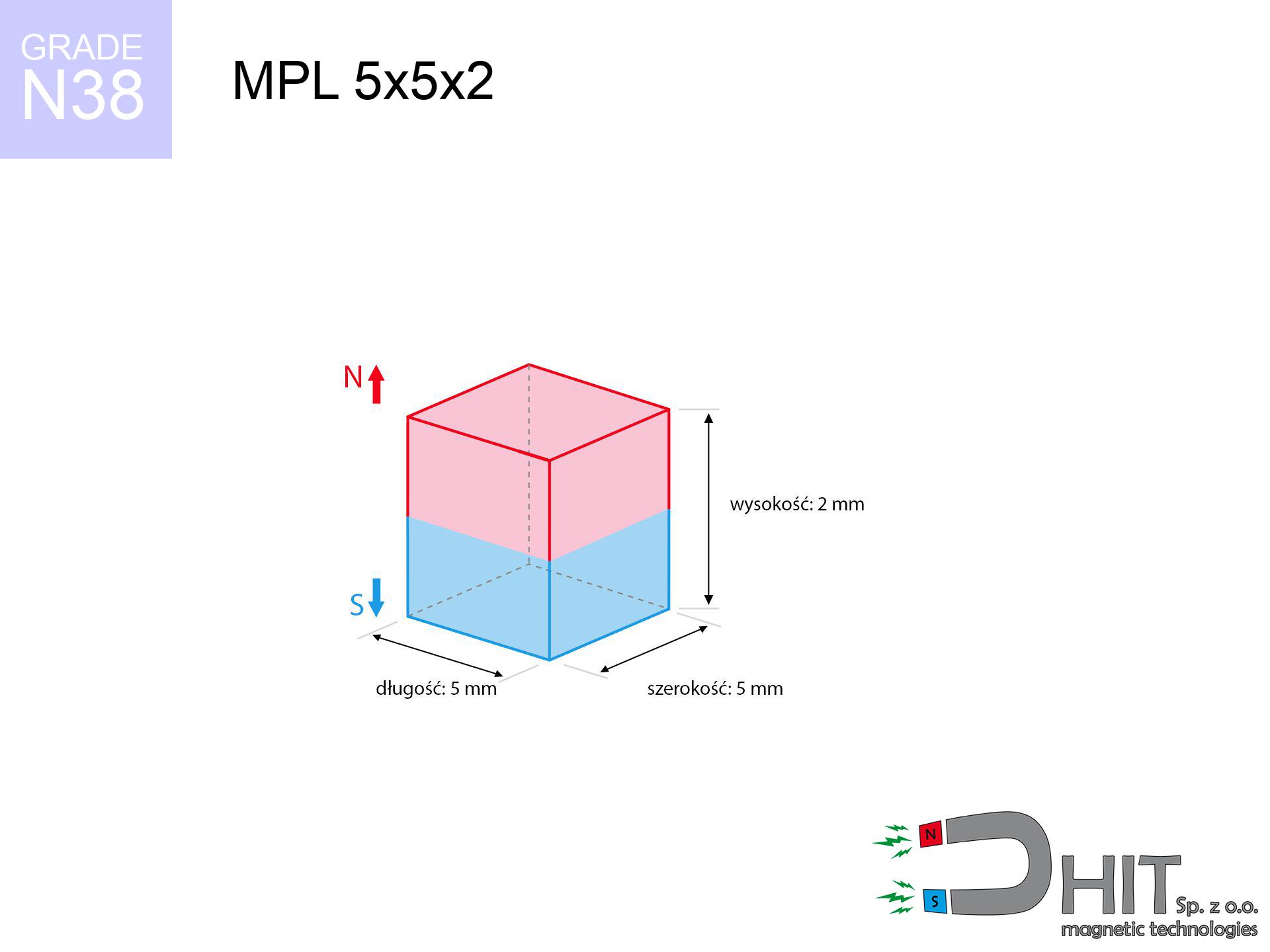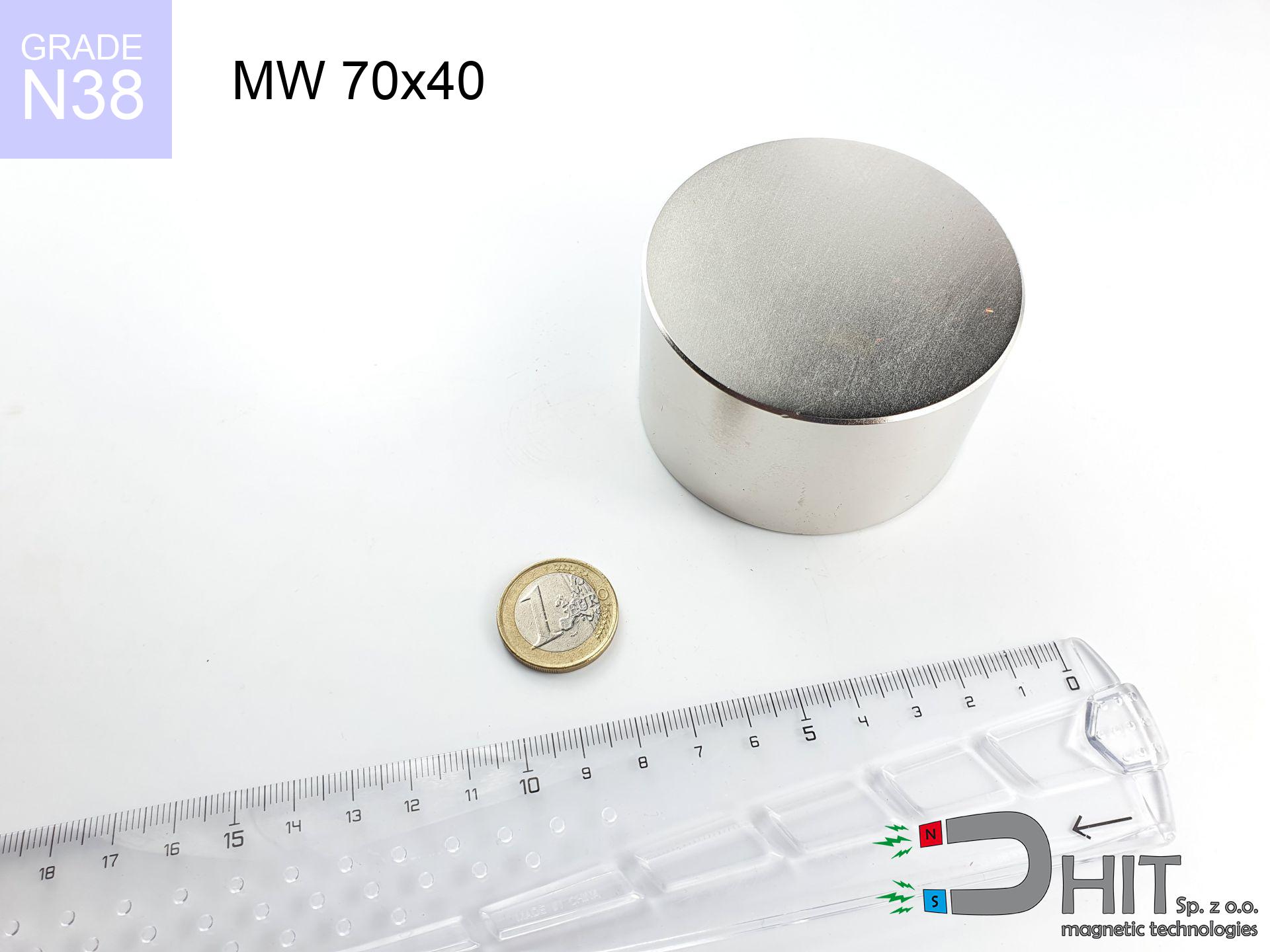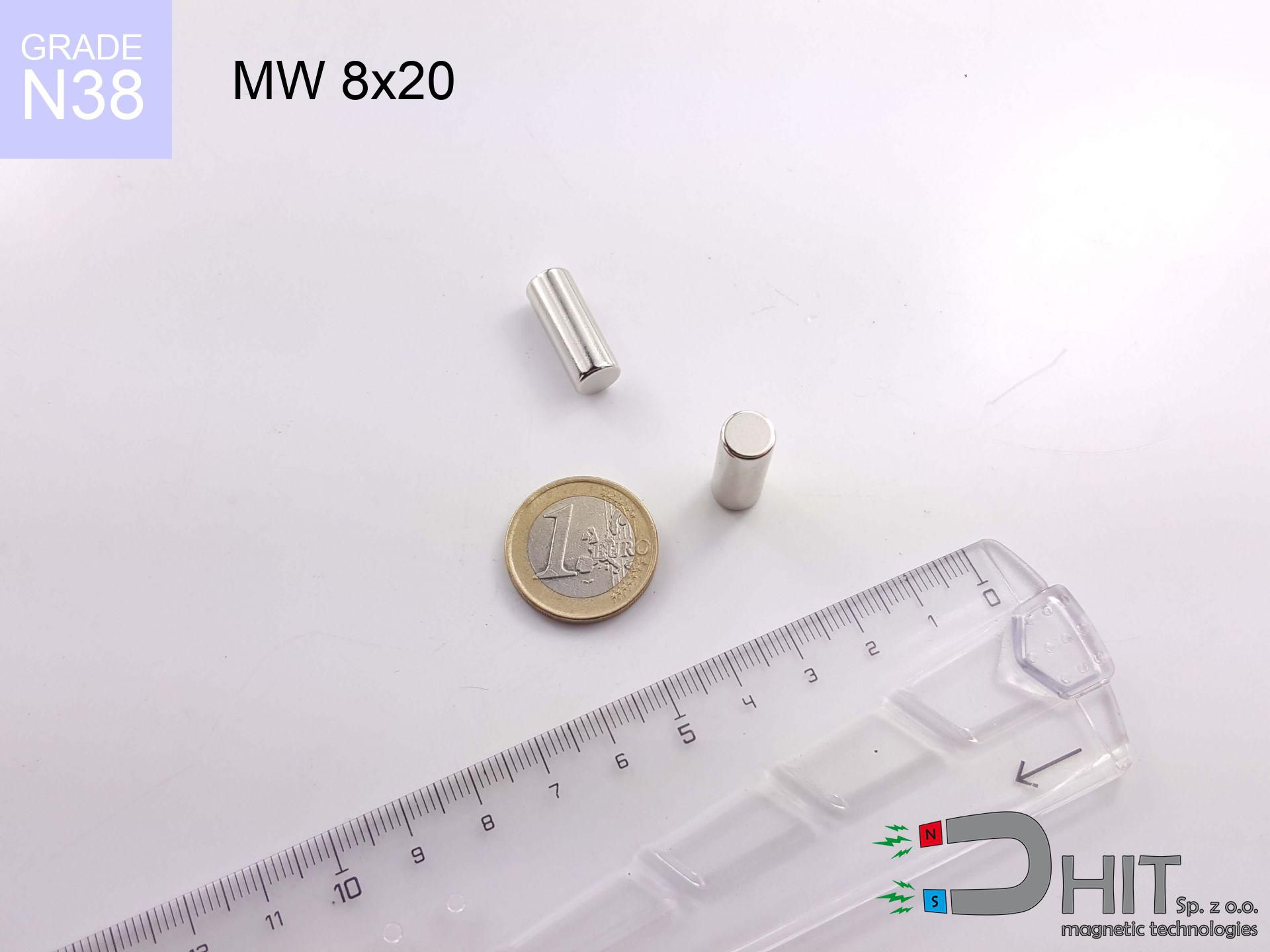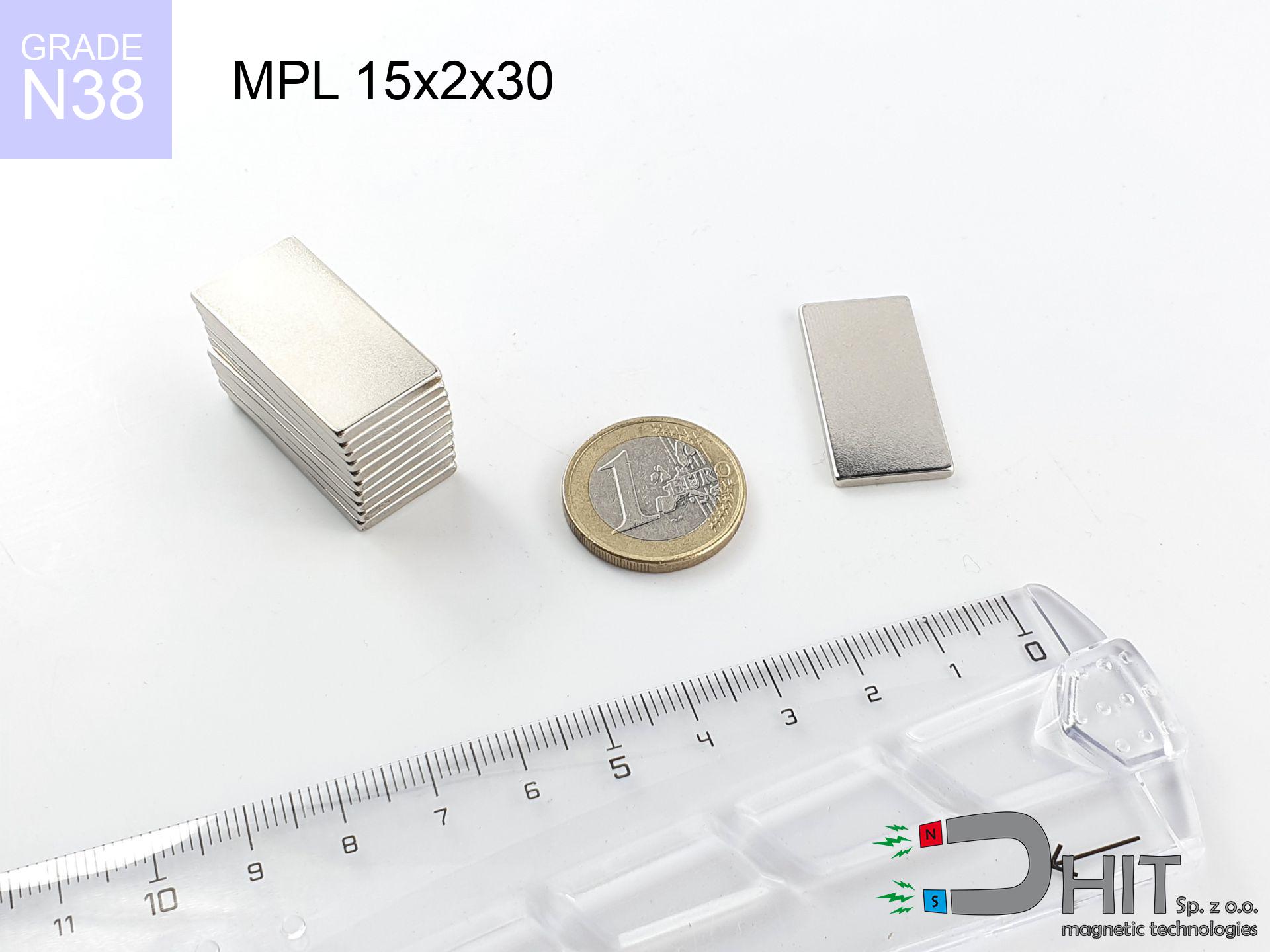MPL 5x5x2 / N38 - neodymium magnet
lamellar magnet
catalog number 020173
GTIN: 5906301811794
length
5
mm [±0,1 mm]
width
5
mm [±0,1 mm]
height
2
mm [±0,1 mm]
magnetizing direction
↑ axial
capacity ~
0.79 kg / 7.75 N
magnetic induction ~
360.52 mT / 3,605 Gs
max. temperature
≤ 80
°C
catalog number 020173
GTIN: 5906301811794
length
5 mm [±0,1 mm]
width
5 mm [±0,1 mm]
height
2 mm [±0,1 mm]
magnetizing direction
↑ axial
capacity ~
0.79 kg / 7.75 N
magnetic induction ~
360.52 mT / 3,605 Gs
max. temperature
≤ 80 °C
0.28 ZŁ gross price (including VAT) / pcs +
0.23 ZŁ net price + 23% VAT / pcs
bulk discounts:
need more quantity?Don't know what to buy?
Give us a call tel: +48 22 499 98 98 or get in touch through form on the contact page. You can check the strength as well as the appearance of magnet in our power calculator magnetic mass calculator
Orders placed by 2:00 PM will be shipped on the same business day.
Specification: lamellar magnet 5x5x2 / N38 ↑ axial
Magnetic properties of the material N38
Physical properties of sintered neodymium magnets Nd2Fe14B
Due to their strength, flat magnets are commonly used in products that need strong holding power.
The standard temperature resistance of these magnets is 80°C, but depending on the dimensions, this value rises.
In addition, flat magnets commonly have different coatings applied to their surfaces, e.g. nickel, gold, or chrome, to increase their corrosion resistance.
The magnet labeled MPL 5x5x2 / N38 i.e. a lifting capacity of 0.79 kg with a weight of a mere 0.38 grams, making it the ideal choice for projects needing a flat magnet.
Contact surface: Thanks to their flat shape, flat magnets guarantee a larger contact surface with adjacent parts, which can be beneficial in applications requiring a stronger magnetic connection.
Technology applications: These are often applied in many devices, such as sensors, stepper motors, or speakers, where the flat shape is necessary for their operation.
Mounting: Their flat shape makes mounting, especially when there's a need to attach the magnet to another surface.
Design flexibility: The flat shape of the magnets permits designers greater flexibility in arranging them in structures, which can be more difficult with magnets of more complex shapes.
Stability: In some applications, the flat base of the flat magnet may offer better stability, minimizing the risk of shifting or rotating. However, it's important to note that the optimal shape of the magnet depends on the specific project and requirements. In some cases, other shapes, such as cylindrical or spherical, may be a better choice.
Magnets have two poles: north (N) and south (S), which attract each other when they are different. Poles of the same kind, such as two north poles, repel each other.
Thanks to this principle of operation, magnets are regularly used in electrical devices, e.g. motors, speakers, sensors, or magnetic locks. Neodymium magnets stand out with the greatest strength of attraction, making them indispensable for applications requiring strong magnetic fields. Moreover, the strength of a magnet depends on its dimensions and the material it is made of.
It’s worth noting that high temperatures can weaken the magnet's effect. The Curie temperature is specific to each type of magnet, meaning that once this temperature is exceeded, the magnet stops being magnetic. Additionally, strong magnets can interfere with the operation of devices, such as navigational instruments, magnetic stripe cards or electronic devices sensitive to magnetic fields. For this reason, it is important to exercise caution when using magnets.
Recommended articles for purchase
Advantages as well as disadvantages of neodymium magnets NdFeB.
In addition to immense power, neodymium magnets have the following advantages:
- They do not lose their power (of the magnet). After approximately 10 years, their strength decreases by only ~1% (theoretically),
- They protect against demagnetization caused by external magnetic sources very well,
- By applying a shiny coating of nickel, gold, or silver, the element gains an aesthetic appearance,
- They have very high magnetic induction on the surface of the magnet,
- By using an appropriate combination of materials, they can achieve high thermal resistance, allowing them to operate at temperatures up to 230°C and above...
- Due to the option of accurate forming or adaptation to individual needs – neodymium magnets can be produced in many variants of shapes or sizes, which amplifies their universality in usage.
- Key role in advanced technologically fields – are utilized in HDD drives, electric motors, medical apparatus or very highly developed apparatuses.
Disadvantages of neodymium magnets:
- They are fragile when subjected to a powerful impact. If the magnets are exposed to impacts, we recommend using magnets in a steel housing. The steel housing in the form of a holder protects the magnet from impacts, and at the same time increases its overall strength,
- Magnets lose their power due to exposure to high temperatures. In most cases, when the temperature exceeds 80°C, these magnets experience permanent reduction in strength (although it is worth noting that this is dependent on the shape and size of the magnet). To avoid this problem, we offer special magnets marked with the [AH] symbol, which exhibit high temperature resistance. They can operate even at temperatures as high as 230°C or more,
- Due to their susceptibility to corrosion in a humid environment, we recommend using waterproof magnets made of rubber, plastic, or other moisture-resistant materials when using them outdoors,
- The use of a cover or a magnetic holder is recommended due to the limited possibilities of manufacturing threads or complex shapes in the magnet
- Health risk associated with microscopic parts of magnets pose a threat, when accidentally ingested, which is particularly important in the context of child safety. It's also worth noting that tiny parts of these devices can hinder the diagnostic process in case of swallowing.
Safety Precautions
Dust and powder from neodymium magnets are flammable.
Avoid drilling or mechanical processing of neodymium magnets. If the magnet is crushed into fine powder or dust, it becomes highly flammable.
Avoid contact with neodymium magnets if you have a nickel allergy.
Studies show a small percentage of people have allergies to certain metals, including nickel. An allergic reaction often manifests as skin redness and rash. If you have a nickel allergy, you can try wearing gloves or simply avoid direct contact with nickel-plated neodymium magnets.
Neodymium magnetic are extremely fragile, they easily crack as well as can become damaged.
Magnets made of neodymium are highly fragile, and by joining them in an uncontrolled manner, they will crack. Neodymium magnets are made of metal and coated with a shiny nickel surface, but they are not as hard as steel. At the moment of connection between the magnets, small metal fragments can be dispersed in different directions.
Neodymium magnets are primarily characterized by their significant internal force. They attract to each other, and any object that comes in their way will be affected.
If joining of neodymium magnets is not under control, at that time they may crumble and also crack. You can't move them to each other. At a distance less than 10 cm you should have them very strongly.
Neodymium magnets can demagnetize at high temperatures.
While Neodymium magnets can lose their magnetic properties at high temperatures, it's important to note that the extent of this effect can vary based on factors such as the magnet's material, shape, and intended application.
Keep neodymium magnets away from children.
Not all neodymium magnets are toys, so do not let children play with them. Small magnets pose a serious choking hazard or can attract to each other in the intestines. In such cases, the only solution is to undergo surgery to remove the magnets, and otherwise, it can even lead to death.
Keep neodymium magnets away from the wallet, computer, and TV.
Neodymium magnets produce strong magnetic fields that can damage magnetic media such as floppy disks, video tapes, HDDs, credit cards, magnetic ID cards, cassette tapes, etc. devices. They can also damage videos, televisions, CRT computer monitors. Remember not to place neodymium magnets close to these electronic devices.
Keep neodymium magnets away from GPS and smartphones.
Magnetic fields can interfere with compasses and magnetometers used in aviation and maritime navigation, as well as internal compasses of smartphones and GPS devices. There are neodymium magnets in every smartphone, for example, in the microphone and speakers.
Neodymium magnets are the strongest magnets ever created, and their strength can shock you.
Please review the information on how to handle neodymium magnets and avoid significant harm to your body, as well as prevent unintentional disruption to the magnets.
People with pacemakers are advised to avoid neodymium magnets.
Neodymium magnets generate very strong magnetic fields that can interfere with the operation of a pacemaker. This is because many of these devices are equipped with a function that deactivates the device in a magnetic field.
To raise awareness of why neodymium magnets are so dangerous, see the article titled How dangerous are very powerful neodymium magnets?.









